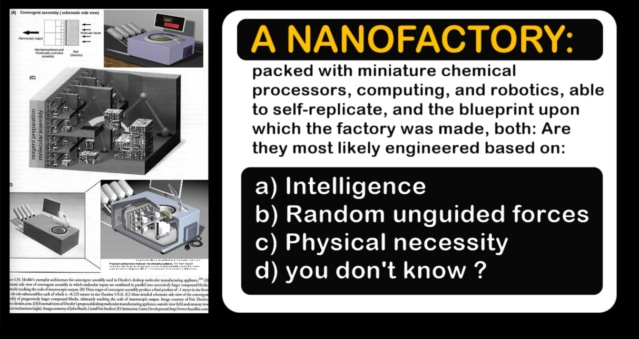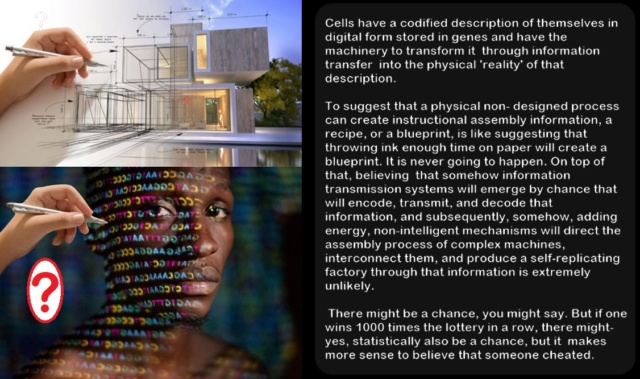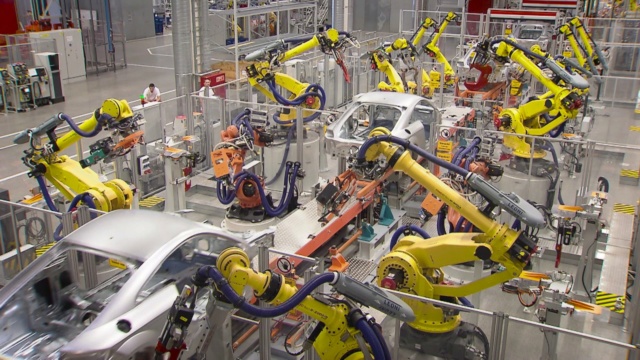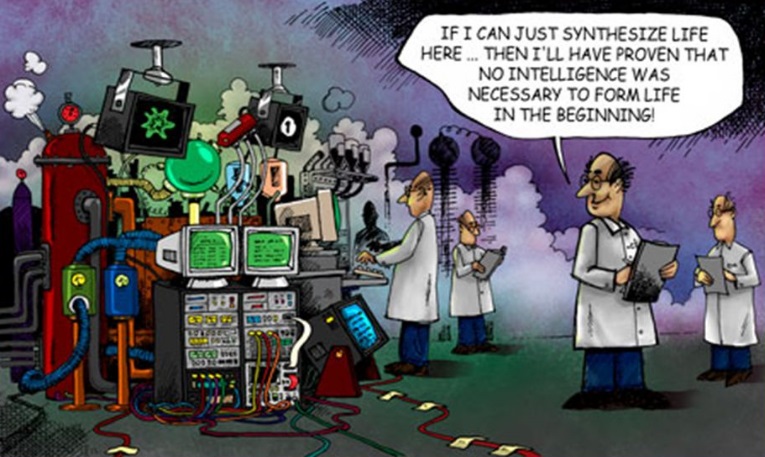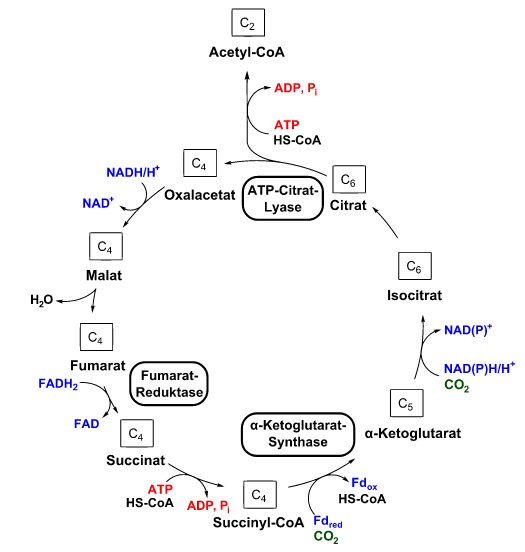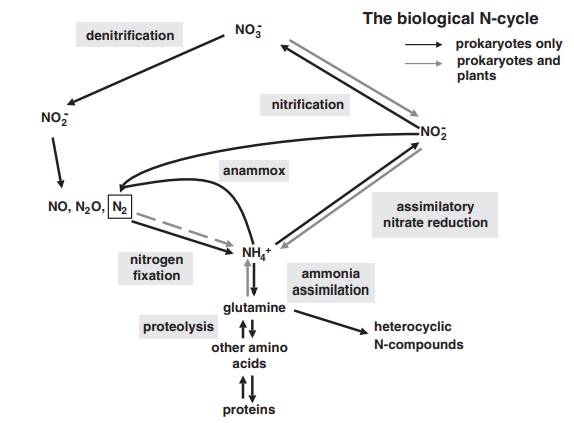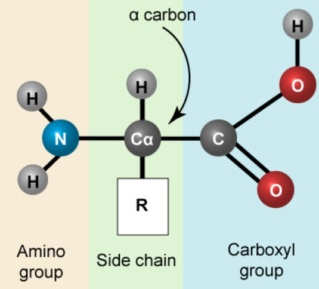Celulas são fábricas ultracomplexas
https://elohim.catsboard.com/t271-celulas-sao-fabricas-ultracomplexas
O Argumento do Fabricante de Fábricas
1. Fábricas são o resultado de design inteligente
2. Células biológicas são fábricas
3. Portanto, as células biológicas são projetadas.
1. Projetos arquitetônicos e edifícios feitos de acordo com as instruções dos mesmos tem sempre uma origem inteligente.
2. A informação instrucional armazenada no DNA direciona a "construção" de células e organismos.
3. A informação genêtica no DNA e células biológicas são, portanto, com grande certeza o resultado de design inteligente.
1. Mentes inteligentes constroem fábricas repletas de máquinas com funções específicas, configuradas para fins específicos. Cada fábrica está cheia de linhas de produção robóticas onde o produto de uma fábrica é entregue ao próxima para processamento adicional até que o produto final seja feito. Cada um dos passos intermediários é essencial. Se houver mal funcionamento ou não funcionamento, como fornecimento de energia ou fornecimento de matérias-primas, a fábrica como um todo cessa sua produção.
2. Células biológicas são um complexo de fábricas de alta tecnologia interligados, totalmente automatizadas e auto-replicantes, hospedando até mais de 2 bilhões de fabricas ( proteinas), como ribossomos e linhas de produção química, cheios de proteínas que agem como robôs, cada um com uma tarefa específica. , função ou objetivo, e completando um ao outro, todo o sistema tem o propósito de sobreviver e perpetuar a vida. Pelo menos 560 proteínas e um metaboloma e genoma totalmente configurados são necessários, e eles são interdependentes. A probabilidade de que um complexo de nano-fábricas tão complexa possa ter emergido por meio de reações químicas não guiadas, não importando em que ambiente primordial, está além da possibilidade de uma a 10 ^ 150.000. O universo hospeda cerca de 10^80 átomos.
3. Células Biológicas são de complexidade gigantesca sem precedentes e design adaptável, muito mais complexo e sofisticado do que qualquer planta fabril artificial. Células auto-replicantes são, portanto, com probabilidade extremamente alta, o produto de um projetista inteligente.
1. Sabe-se que a fabricação de computadores, máquinas complexas e fábricas são sempre rastreadas até o design inteligente
2. Células biológicas SÃO (sem analogia) um parque industrial, hospedando mais de 2 bilhões de proteínas, como ribossomos (em células humanas) que são interligadas fábricas de alta tecnologia
3. As células auto-replicantes biológicas foram, com uma probabilidade extremamente alta, inteligentemente projetadas e criadas.
1. Máquinas High-tech, Computatores, linhas de montagens e parques de fábricas complexas interligadas são inteligentemente projetadas
2. Células biológicas são um parque de bilhões de fábricas high-tech interconectadas (proteinas), cheio de maquinas moleculares ( enzimas), linhas de montagem, e computatores.
3. Células biológicas são inteligentemente projetadas.
Ninguém em sua mente sã defenderia e advogaria que computadores, hardware, software, uma linguagem usando sinais e códigos como o alfabeto, um projeto instrucional, máquinas complexas, linhas de montagem de fábrica, sistemas de verificação e reparo de erros, métodos de reciclagem, trituradores de resíduos e gerenciamento , usinas geradoras de energia, turbinas elétricas e circuitos elétricos podem surgir aleatoriamente, por eventos acidentais não guiados. Essa é, no entanto, a ÚNICA alternativa causal, uma vez que o planejamento inteligente, invenção, projeto e implementação são excluídos, para explicar a origem das Células biológicas, que são fábricas miniaturizadas, ultramplexas, moleculares e auto-replicantes.
Fábricas, cheias de máquinas e linhas de produção e computadores, são originárias de mentes inteligentes. Nenhuma exceção.
As células biológicas são como um parque industrial de várias fábricas interligadas, trabalhando em conjunto.
A palavra fábrica é do latim, e significa fabricare, ou fazer, produzir. E isso é PRECISAMENTE o que as células fazem. Elas produzem outras células através de auto-replicação, através de processamento complexo mediante máquinas moleculares, linhas de produção, computação etc.
Portanto, elas tinham o mais provavelmente uma mente como uma agência causal.
A reivindicação é falsificada e refutada, uma vez que alguém pode demonstrar uma fábrica que pode se auto-montar, sem a exigência de inteligência.
A existência de Deus é um fato, tanto quanto o fato de que fábricas não se auto-montam espontaneamente por agregação ordenada e maneira sequencialmente correta sem direção externa.
Mas quem sabe, Wikipedia, um site anti-ID comumente conhecido, está certo ?? Eles alegam:
O exemplo mais famoso de fenômeno de automontagem é a ocorrência da vida na Terra. É plausível supor que isso acontece porque o sol gera um forte gradiente temperado em seu ambiente. Será ?
A inferência de um designer inteligente como a melhor explicação da origem do mundo físico não é baseada na falta de conhecimento, lacunas e ignorância, mas abundantes evidencias científicas positivas.
- um departamento de projeto
- computadores que armazenam os projetos e projetos de fabricação
- um índice de biblioteca e um programa de classificação, armazenamento e recuperação de informações totalmente automatizado
- Unidades de armazenamento de material
- Alfa e Beta Testers
- seguranças
- um escritório de controle
- estruturas de apoio da construção da fábrica
- portais de fábrica com pontos de controle de segurança totalmente automatizados e controle
- compartimentos de fábrica
- computadores, hardware
- software, uma linguagem que usa sinais e códigos como o alfabeto, e plantas instrucionais e manuais de produção
- recuperação de informação
- canais de transmissão de informação
- sistemas de tradução de informação
- máquinas complexas
- veículos de entrega de material interno de fábrica
- passagens de fábricas e rodovias
- vários compartimentos, departamentos de produção e seções
- programas de marcação
- linhas de montagem de fábrica
- verificação de erros de fabricação e sistemas de reparo
- métodos de reciclagem
- trituradores de resíduos e gestão
- usinas de geração de energia
- turbinas de potência
- circuitos elétricos
- loops de feedback
Tudo acima se aplica a fábricas de células biológicas.
Células Biológicas:
- um departamento de projeto (?)
- computadores que armazenam os projetos e projetos de fabricação
- portais de fábrica com pontos de verificação de segurança totalmente automatizados e controle (proteínas de membrana)
- compartimentos de fábrica (organelas)
- um índice de biblioteca e um programa de classificação, armazenamento e recuperação de informação totalmente automatizado (cromossomos e a rede de regulação genética)
- computadores moleculares, hardware (DNA)
- software, uma linguagem que usa sinais e códigos como o alfabeto, um projeto instrucional, (o código genético e mais de uma dúzia de códigos epigenéticos)
- recuperação de informação (RNA polimerase)
- transmissão (RNA mensageiro)
- tradução (ribossomo)
- sinalização (hormônios)
- máquinas complexas (proteínas)
- táxis (dineína, cinesina, vesículas de transporte)
- rodovias moleculares (tubulinas, utilizadas pelas proteínas dineína e cinesina para o transporte molecular para vários destinos)
- programas de marcação (cada proteína tem uma etiqueta, que é uma sequência de aminoácidos) informando outras máquinas de transporte molecular onde transportá-las.
- linhas de montagem de fábrica (sintase de ácidos graxos, sintase peptídica não ribossômica)
- sistemas de verificação e reparação de erros (revisão exonucleolítica, reparação de divergência orientada por vertentes)
- métodos de reciclagem (reciclagem endocítica)
- trituradores de resíduos e gerenciamento (Moedores de lixo Proteasome)
- usinas geradoras de energia (mitocôndrias)
- turbinas de potência (ATP synthase)
- circuitos elétricos (a rede metabólica)
- O universo teve um começo, portanto, uma causa
- As leis físicas tiveram que surgir em conjunto com espaço e matéria
- O universo físico está finamente sintonizado para hospedar a vida
- Existe realidade mental
- Os sistemas biológicos aparecem projetados
- O DNA armazena o plano de construção de organismos biologicos
- Informações complexas instrucionais sempre têm origem mental
- Os sistemas biológicos funcionam de forma interdependente
- As células biológicas requerem um número mínimo de partes e um proteoma, genoma e metabolome mínimos para a vida poder começar e, portanto, são irredutíveis
- A vida não poderia surgir de forma gradual, mas só de uma só vez
- As vias metabólicas são como circuitos eletrônicos
- A consciência, o livre arbítrio, os valores morais e a lógica não podem emergir da matéria
- Lógica e linguagem não podem emergir da não-vida
- Fábricas nunca foram observadas de se auto-montarem
- As células biológicas são fábricas complexas cheias de máquinas nano-moleculares, e linhas de produção
- A abiogênese é impossível. Mesmo as células mais simples são muito complexas para emergirem de eventos aleatórios sem orientação e planejamento e antevisão do produto final.
- O único mecanismo para explicar a origem da vida, uma vez que o projeto é excluído, é auto-montagem por um acidente sortudo.
- A auto-replicação é o epítome do avanço e sofisticação de produção e fabricação
- Existe uma atribuição de codões a aminoácidos que é arbitrário
- A ciência baseada no naturalismo metodológico é incapaz de explicar a origem do código genético, a cifra genética, a informação genética e a epigenética.
- A vida exige hardware e software para instruir como construir organismos biológicos
- As células biológicas são feitas de diversas máquinas moleculares complexas interligadas, e usam uma rede complexa de motores de células que trabalham de forma cooperativa, e interligadas, e fábricas miniaturizadas (ribossomos, retículo endoplásmico, fábricas de transcrição , fábricas de membranas, e literalmente, linhas de montagem e produção )
- As células usam a mesma informação para fazer vários produtos (spliceosome)
- As células usam mecanismos complexos de verificação e reparação de erros que tinham que estar totalmente configuradas e operacional quando a vida começou
- O DNA é o mais pequeno sistema de armazenamento de informações conhecido
- A rede reguladora de genes instrui quando expressar os genes certos
- As células usam redes avançadas de comunicação e sinalização
- A sinalização celular depende do ambiente homeostático correto dentro da célula.
- A concentração de cálcio dentro da célula deve ser 20,000 vezes menor do que no meio extracelular, de outra forma, não haveria sinalização e comunicação dentro das células, e vida seria impossível.
- A membrana celular e as proteínas da membrana são interdependentes.
Bactérias e células eucarióticas têm membranas diferentes e a maquinaria de replicação de DNA também é diferente, fato que falsifica a reivindicação de ascendência comum
- A explosão cambriana falsifica evolução gradual
- A informação epigenética falsifica a teoria de Darwin, e a reivindicação de seleção natural como mecanismo exclusivo de variação biológica, especiação, complexidade, forma e biodiversidade
Objeção: a analogia com fábricas não faz sentido, fabricas não se reproduzem, elas não podem produzir variações pra ser selecionadas.
Resposta: Um dos argumentos mais comuns dos ateus, ao explicar que as células biológicas são fábricas complexas, é que as células são auto-replicantes, enquanto as fábricas feitas pelo homem não são. Este é, no entanto, um argumento autodestrutivo, porque não é levado em consideração, que a auto-replicação é o epítome do avanço e da realização de fabricação, longe de ser realizado por fábricas feitas pelo homem.
A auto-replicação teve que surgir e ser implementada primeiro, antes que a evolução poderia ter começado a agir, o que levanta o problema intransponível de que a replicação do DNA é irredutivelmente complexa:
Replicação de DNA, e sua extraordinária nano-tecnologia que desafia explicações naturalistas
http://elohim.heavenforum.org/t183-replicacao-de-dna-e-sua-extraordinaria-nano-tecnologia-que-desafia-explicacoes-naturalistas#302
De fato, o mais alto grau de performance de fabricação, excelência, precisão, eficiência energética, adaptabilidade a mudanças externas, economia, refinamento e inteligência de automação de produção (em uma escala de 1 -100, = 100) encontramos em procedimentos adotados por cada célula, análogo a uma fábrica, e caminhos de biossíntese e processos em biologia. Uma célula usa uma rede complexa de caminhos metabólicos, cada uma composta de cadeias de reações químicas em que o produto de uma enzima se torna o substrato da próxima. Neste labirinto de caminhos, existem muitos pontos de ramificação onde diferentes enzimas competem pelo mesmo substrato. O sistema é tão complexo que são necessários controles elaborados para regular quando e com que rapidez cada reação ocorre. Como uma linha de produção da fábrica, cada enzima catalisa uma reação específica, usando o produto da enzima a montante e passando o resultado para a enzima a jusante.
The Design of the Simplest Self-Replicating living cell
http://reasonandscience.heavenforum.org/t2125-the-design-of-the-simplest-self-replicating-living-cell
Você diria que é plausível que eventos aleatórios, não guiados e naturais tenham probabilidade estatística suficiente para criar e dar origem à mais sofisticada fábrica auto-replicante do universo? - contendo um sistema de código informativo e linguagens de programação como nosso alfabeto ou um código de computador, mais versátil do que C, Visual Basic ou PHP, e mais robusto e propenso a erros do que qualquer outro sistema de código de 1 milhão de alternativas? - usando um protocolo de comunicação que desperdiça muito menos espaço que o TCP / IP e é mais robusto do que Ethernet? - usando, além disso, uma coleção de regras e regularidades de informação que codificam textos complexos de instrução? - definido pelo alfabeto, gramática, uma coleção de sinais de pontuação e sites regulatórios e semântica? E, em seguida, usa esse sistema de código para criar um modelo para uma fábrica auto-replicante, que requer cerca de 1500 livros, cada um com 300 páginas, 300.000,00 caracteres por livro, cada um contendo as instruções complexas precisas e informações para criar esta fábrica e armazenadas No menor dispositivo de armazenamento possível e conhecido, um trilhão de vezes mais denso do que um CD?
Fábricas complexas contêm linhas de produção, máquinas complexas interdependentes que produzem peças complexas para outras máquinas e subunidades que, depois de feitas, devem ser e são montadas da maneira correta - máquinas de fabricação que funcionam independentemente da entrada externa de informação, mas que foram pré-programadas para fazer seu trabalho de forma autônoma, como robôs, com departamentos de controle de qualidade, verificação de erros e mecanismos de reparação para manter a menor taxa de erro, paredes que fazem a separação do interior para fora da fábrica para proteção e com portões que permitem entrada e saída de carga, Mecanismos de reconhecimento que permitem apenas a carga certa e conduzam-no aos locais específicos e linhas de produção, rodovias e operadoras de carga que possuem marcas que reconhecem onde descartar a carga onde é necessário, limpa o lixo e possui lixeiras e recicla sofisticada Mecanismos, departamentos de armazenamento, produz sua energia e desloca-a para onde é necessário, e, pelo menos, não se reproduz, exige você Sem dúvida, mentes inteligentes para configurá-lo.
As células biológicas atendem à descrição acima.
Portanto, a inferência mais racional é que as células biológicas e a vida tinham uma fonte inteligente como causa e origem.
Eu: Design inteligente é um fato
Ateu: Prove
Eu: Fabricas nunca se auto-constroem. Celulas biológicas são fábricas ultracomplexas
Ateu: Isto não torna o design inteligente um fato. Muito menos um fato cientifico. Me mostre o designer inteligente criando sistemas biolgicas.
Eu: Observação direta não é necessária. Ateus também alegam com frequencia que a evolução é um fato. Voce tem como me demonstrar um organismo unicellular se tornando um organismo complexo , multicellular, como um ser hum.ano ?
Ateu: Não é assim que funciona. Isso leva milhões de anos......
Proponente DI: Design inteligente é cientifico, e pode ser testado
Naturalista : Discordo
Proponente DI: Posso estabelecer uma teoria cientifica baseada na observação, que fabricas apenas se constroem mediante design inteligente. Celulas biológicas equivalem a um parque inteiro de várias fábricas inteligadas. ultracomplexas. A teoria é falsificada, uma vez que pode ser demonstrado, que células biologicas podem surgir mediante mecanismos não guiados, não inteligentes.
Naturalista: Se não tem como demonstrar o designer atuando, o DI não é cientifico. Me mostre o designer inteligente criando sistemas biolgicas, e a coisa muda.....
Proponente DI: Observação direta não é necessária. Naturalistas também alegam com frequencia que a evolução é um fato. Voce tem como me demonstrar um organismo unicellular se tornando um organismo complexo , multicellular, como um ser humano ?
Naturalista: Não é assim que funciona. Isso leva milhões de anos...... micro leva a macro......

https://elohim.catsboard.com/t271-celulas-sao-fabricas-ultracomplexas
O Argumento do Fabricante de Fábricas
1. Fábricas são o resultado de design inteligente
2. Células biológicas são fábricas
3. Portanto, as células biológicas são projetadas.
1. Projetos arquitetônicos e edifícios feitos de acordo com as instruções dos mesmos tem sempre uma origem inteligente.
2. A informação instrucional armazenada no DNA direciona a "construção" de células e organismos.
3. A informação genêtica no DNA e células biológicas são, portanto, com grande certeza o resultado de design inteligente.
1. Mentes inteligentes constroem fábricas repletas de máquinas com funções específicas, configuradas para fins específicos. Cada fábrica está cheia de linhas de produção robóticas onde o produto de uma fábrica é entregue ao próxima para processamento adicional até que o produto final seja feito. Cada um dos passos intermediários é essencial. Se houver mal funcionamento ou não funcionamento, como fornecimento de energia ou fornecimento de matérias-primas, a fábrica como um todo cessa sua produção.
2. Células biológicas são um complexo de fábricas de alta tecnologia interligados, totalmente automatizadas e auto-replicantes, hospedando até mais de 2 bilhões de fabricas ( proteinas), como ribossomos e linhas de produção química, cheios de proteínas que agem como robôs, cada um com uma tarefa específica. , função ou objetivo, e completando um ao outro, todo o sistema tem o propósito de sobreviver e perpetuar a vida. Pelo menos 560 proteínas e um metaboloma e genoma totalmente configurados são necessários, e eles são interdependentes. A probabilidade de que um complexo de nano-fábricas tão complexa possa ter emergido por meio de reações químicas não guiadas, não importando em que ambiente primordial, está além da possibilidade de uma a 10 ^ 150.000. O universo hospeda cerca de 10^80 átomos.
3. Células Biológicas são de complexidade gigantesca sem precedentes e design adaptável, muito mais complexo e sofisticado do que qualquer planta fabril artificial. Células auto-replicantes são, portanto, com probabilidade extremamente alta, o produto de um projetista inteligente.
1. Sabe-se que a fabricação de computadores, máquinas complexas e fábricas são sempre rastreadas até o design inteligente
2. Células biológicas SÃO (sem analogia) um parque industrial, hospedando mais de 2 bilhões de proteínas, como ribossomos (em células humanas) que são interligadas fábricas de alta tecnologia
3. As células auto-replicantes biológicas foram, com uma probabilidade extremamente alta, inteligentemente projetadas e criadas.
1. Máquinas High-tech, Computatores, linhas de montagens e parques de fábricas complexas interligadas são inteligentemente projetadas
2. Células biológicas são um parque de bilhões de fábricas high-tech interconectadas (proteinas), cheio de maquinas moleculares ( enzimas), linhas de montagem, e computatores.
3. Células biológicas são inteligentemente projetadas.
Ninguém em sua mente sã defenderia e advogaria que computadores, hardware, software, uma linguagem usando sinais e códigos como o alfabeto, um projeto instrucional, máquinas complexas, linhas de montagem de fábrica, sistemas de verificação e reparo de erros, métodos de reciclagem, trituradores de resíduos e gerenciamento , usinas geradoras de energia, turbinas elétricas e circuitos elétricos podem surgir aleatoriamente, por eventos acidentais não guiados. Essa é, no entanto, a ÚNICA alternativa causal, uma vez que o planejamento inteligente, invenção, projeto e implementação são excluídos, para explicar a origem das Células biológicas, que são fábricas miniaturizadas, ultramplexas, moleculares e auto-replicantes.
Fábricas, cheias de máquinas e linhas de produção e computadores, são originárias de mentes inteligentes. Nenhuma exceção.
As células biológicas são como um parque industrial de várias fábricas interligadas, trabalhando em conjunto.
A palavra fábrica é do latim, e significa fabricare, ou fazer, produzir. E isso é PRECISAMENTE o que as células fazem. Elas produzem outras células através de auto-replicação, através de processamento complexo mediante máquinas moleculares, linhas de produção, computação etc.
Portanto, elas tinham o mais provavelmente uma mente como uma agência causal.
A reivindicação é falsificada e refutada, uma vez que alguém pode demonstrar uma fábrica que pode se auto-montar, sem a exigência de inteligência.
A existência de Deus é um fato, tanto quanto o fato de que fábricas não se auto-montam espontaneamente por agregação ordenada e maneira sequencialmente correta sem direção externa.
Mas quem sabe, Wikipedia, um site anti-ID comumente conhecido, está certo ?? Eles alegam:
O exemplo mais famoso de fenômeno de automontagem é a ocorrência da vida na Terra. É plausível supor que isso acontece porque o sol gera um forte gradiente temperado em seu ambiente. Será ?
A inferência de um designer inteligente como a melhor explicação da origem do mundo físico não é baseada na falta de conhecimento, lacunas e ignorância, mas abundantes evidencias científicas positivas.
- um departamento de projeto
- computadores que armazenam os projetos e projetos de fabricação
- um índice de biblioteca e um programa de classificação, armazenamento e recuperação de informações totalmente automatizado
- Unidades de armazenamento de material
- Alfa e Beta Testers
- seguranças
- um escritório de controle
- estruturas de apoio da construção da fábrica
- portais de fábrica com pontos de controle de segurança totalmente automatizados e controle
- compartimentos de fábrica
- computadores, hardware
- software, uma linguagem que usa sinais e códigos como o alfabeto, e plantas instrucionais e manuais de produção
- recuperação de informação
- canais de transmissão de informação
- sistemas de tradução de informação
- máquinas complexas
- veículos de entrega de material interno de fábrica
- passagens de fábricas e rodovias
- vários compartimentos, departamentos de produção e seções
- programas de marcação
- linhas de montagem de fábrica
- verificação de erros de fabricação e sistemas de reparo
- métodos de reciclagem
- trituradores de resíduos e gestão
- usinas de geração de energia
- turbinas de potência
- circuitos elétricos
- loops de feedback
Tudo acima se aplica a fábricas de células biológicas.
Células Biológicas:
- um departamento de projeto (?)
- computadores que armazenam os projetos e projetos de fabricação
- portais de fábrica com pontos de verificação de segurança totalmente automatizados e controle (proteínas de membrana)
- compartimentos de fábrica (organelas)
- um índice de biblioteca e um programa de classificação, armazenamento e recuperação de informação totalmente automatizado (cromossomos e a rede de regulação genética)
- computadores moleculares, hardware (DNA)
- software, uma linguagem que usa sinais e códigos como o alfabeto, um projeto instrucional, (o código genético e mais de uma dúzia de códigos epigenéticos)
- recuperação de informação (RNA polimerase)
- transmissão (RNA mensageiro)
- tradução (ribossomo)
- sinalização (hormônios)
- máquinas complexas (proteínas)
- táxis (dineína, cinesina, vesículas de transporte)
- rodovias moleculares (tubulinas, utilizadas pelas proteínas dineína e cinesina para o transporte molecular para vários destinos)
- programas de marcação (cada proteína tem uma etiqueta, que é uma sequência de aminoácidos) informando outras máquinas de transporte molecular onde transportá-las.
- linhas de montagem de fábrica (sintase de ácidos graxos, sintase peptídica não ribossômica)
- sistemas de verificação e reparação de erros (revisão exonucleolítica, reparação de divergência orientada por vertentes)
- métodos de reciclagem (reciclagem endocítica)
- trituradores de resíduos e gerenciamento (Moedores de lixo Proteasome)
- usinas geradoras de energia (mitocôndrias)
- turbinas de potência (ATP synthase)
- circuitos elétricos (a rede metabólica)
- O universo teve um começo, portanto, uma causa
- As leis físicas tiveram que surgir em conjunto com espaço e matéria
- O universo físico está finamente sintonizado para hospedar a vida
- Existe realidade mental
- Os sistemas biológicos aparecem projetados
- O DNA armazena o plano de construção de organismos biologicos
- Informações complexas instrucionais sempre têm origem mental
- Os sistemas biológicos funcionam de forma interdependente
- As células biológicas requerem um número mínimo de partes e um proteoma, genoma e metabolome mínimos para a vida poder começar e, portanto, são irredutíveis
- A vida não poderia surgir de forma gradual, mas só de uma só vez
- As vias metabólicas são como circuitos eletrônicos
- A consciência, o livre arbítrio, os valores morais e a lógica não podem emergir da matéria
- Lógica e linguagem não podem emergir da não-vida
- Fábricas nunca foram observadas de se auto-montarem
- As células biológicas são fábricas complexas cheias de máquinas nano-moleculares, e linhas de produção
- A abiogênese é impossível. Mesmo as células mais simples são muito complexas para emergirem de eventos aleatórios sem orientação e planejamento e antevisão do produto final.
- O único mecanismo para explicar a origem da vida, uma vez que o projeto é excluído, é auto-montagem por um acidente sortudo.
- A auto-replicação é o epítome do avanço e sofisticação de produção e fabricação
- Existe uma atribuição de codões a aminoácidos que é arbitrário
- A ciência baseada no naturalismo metodológico é incapaz de explicar a origem do código genético, a cifra genética, a informação genética e a epigenética.
- A vida exige hardware e software para instruir como construir organismos biológicos
- As células biológicas são feitas de diversas máquinas moleculares complexas interligadas, e usam uma rede complexa de motores de células que trabalham de forma cooperativa, e interligadas, e fábricas miniaturizadas (ribossomos, retículo endoplásmico, fábricas de transcrição , fábricas de membranas, e literalmente, linhas de montagem e produção )
- As células usam a mesma informação para fazer vários produtos (spliceosome)
- As células usam mecanismos complexos de verificação e reparação de erros que tinham que estar totalmente configuradas e operacional quando a vida começou
- O DNA é o mais pequeno sistema de armazenamento de informações conhecido
- A rede reguladora de genes instrui quando expressar os genes certos
- As células usam redes avançadas de comunicação e sinalização
- A sinalização celular depende do ambiente homeostático correto dentro da célula.
- A concentração de cálcio dentro da célula deve ser 20,000 vezes menor do que no meio extracelular, de outra forma, não haveria sinalização e comunicação dentro das células, e vida seria impossível.
- A membrana celular e as proteínas da membrana são interdependentes.
Bactérias e células eucarióticas têm membranas diferentes e a maquinaria de replicação de DNA também é diferente, fato que falsifica a reivindicação de ascendência comum
- A explosão cambriana falsifica evolução gradual
- A informação epigenética falsifica a teoria de Darwin, e a reivindicação de seleção natural como mecanismo exclusivo de variação biológica, especiação, complexidade, forma e biodiversidade
Objeção: a analogia com fábricas não faz sentido, fabricas não se reproduzem, elas não podem produzir variações pra ser selecionadas.
Resposta: Um dos argumentos mais comuns dos ateus, ao explicar que as células biológicas são fábricas complexas, é que as células são auto-replicantes, enquanto as fábricas feitas pelo homem não são. Este é, no entanto, um argumento autodestrutivo, porque não é levado em consideração, que a auto-replicação é o epítome do avanço e da realização de fabricação, longe de ser realizado por fábricas feitas pelo homem.
A auto-replicação teve que surgir e ser implementada primeiro, antes que a evolução poderia ter começado a agir, o que levanta o problema intransponível de que a replicação do DNA é irredutivelmente complexa:
Replicação de DNA, e sua extraordinária nano-tecnologia que desafia explicações naturalistas
http://elohim.heavenforum.org/t183-replicacao-de-dna-e-sua-extraordinaria-nano-tecnologia-que-desafia-explicacoes-naturalistas#302
De fato, o mais alto grau de performance de fabricação, excelência, precisão, eficiência energética, adaptabilidade a mudanças externas, economia, refinamento e inteligência de automação de produção (em uma escala de 1 -100, = 100) encontramos em procedimentos adotados por cada célula, análogo a uma fábrica, e caminhos de biossíntese e processos em biologia. Uma célula usa uma rede complexa de caminhos metabólicos, cada uma composta de cadeias de reações químicas em que o produto de uma enzima se torna o substrato da próxima. Neste labirinto de caminhos, existem muitos pontos de ramificação onde diferentes enzimas competem pelo mesmo substrato. O sistema é tão complexo que são necessários controles elaborados para regular quando e com que rapidez cada reação ocorre. Como uma linha de produção da fábrica, cada enzima catalisa uma reação específica, usando o produto da enzima a montante e passando o resultado para a enzima a jusante.
The Design of the Simplest Self-Replicating living cell
http://reasonandscience.heavenforum.org/t2125-the-design-of-the-simplest-self-replicating-living-cell
Você diria que é plausível que eventos aleatórios, não guiados e naturais tenham probabilidade estatística suficiente para criar e dar origem à mais sofisticada fábrica auto-replicante do universo? - contendo um sistema de código informativo e linguagens de programação como nosso alfabeto ou um código de computador, mais versátil do que C, Visual Basic ou PHP, e mais robusto e propenso a erros do que qualquer outro sistema de código de 1 milhão de alternativas? - usando um protocolo de comunicação que desperdiça muito menos espaço que o TCP / IP e é mais robusto do que Ethernet? - usando, além disso, uma coleção de regras e regularidades de informação que codificam textos complexos de instrução? - definido pelo alfabeto, gramática, uma coleção de sinais de pontuação e sites regulatórios e semântica? E, em seguida, usa esse sistema de código para criar um modelo para uma fábrica auto-replicante, que requer cerca de 1500 livros, cada um com 300 páginas, 300.000,00 caracteres por livro, cada um contendo as instruções complexas precisas e informações para criar esta fábrica e armazenadas No menor dispositivo de armazenamento possível e conhecido, um trilhão de vezes mais denso do que um CD?
Fábricas complexas contêm linhas de produção, máquinas complexas interdependentes que produzem peças complexas para outras máquinas e subunidades que, depois de feitas, devem ser e são montadas da maneira correta - máquinas de fabricação que funcionam independentemente da entrada externa de informação, mas que foram pré-programadas para fazer seu trabalho de forma autônoma, como robôs, com departamentos de controle de qualidade, verificação de erros e mecanismos de reparação para manter a menor taxa de erro, paredes que fazem a separação do interior para fora da fábrica para proteção e com portões que permitem entrada e saída de carga, Mecanismos de reconhecimento que permitem apenas a carga certa e conduzam-no aos locais específicos e linhas de produção, rodovias e operadoras de carga que possuem marcas que reconhecem onde descartar a carga onde é necessário, limpa o lixo e possui lixeiras e recicla sofisticada Mecanismos, departamentos de armazenamento, produz sua energia e desloca-a para onde é necessário, e, pelo menos, não se reproduz, exige você Sem dúvida, mentes inteligentes para configurá-lo.
As células biológicas atendem à descrição acima.
Portanto, a inferência mais racional é que as células biológicas e a vida tinham uma fonte inteligente como causa e origem.
Eu: Design inteligente é um fato
Ateu: Prove
Eu: Fabricas nunca se auto-constroem. Celulas biológicas são fábricas ultracomplexas
Ateu: Isto não torna o design inteligente um fato. Muito menos um fato cientifico. Me mostre o designer inteligente criando sistemas biolgicas.
Eu: Observação direta não é necessária. Ateus também alegam com frequencia que a evolução é um fato. Voce tem como me demonstrar um organismo unicellular se tornando um organismo complexo , multicellular, como um ser hum.ano ?
Ateu: Não é assim que funciona. Isso leva milhões de anos......
Proponente DI: Design inteligente é cientifico, e pode ser testado
Naturalista : Discordo
Proponente DI: Posso estabelecer uma teoria cientifica baseada na observação, que fabricas apenas se constroem mediante design inteligente. Celulas biológicas equivalem a um parque inteiro de várias fábricas inteligadas. ultracomplexas. A teoria é falsificada, uma vez que pode ser demonstrado, que células biologicas podem surgir mediante mecanismos não guiados, não inteligentes.
Naturalista: Se não tem como demonstrar o designer atuando, o DI não é cientifico. Me mostre o designer inteligente criando sistemas biolgicas, e a coisa muda.....
Proponente DI: Observação direta não é necessária. Naturalistas também alegam com frequencia que a evolução é um fato. Voce tem como me demonstrar um organismo unicellular se tornando um organismo complexo , multicellular, como um ser humano ?
Naturalista: Não é assim que funciona. Isso leva milhões de anos...... micro leva a macro......

Última edição por Admin em Sáb Mar 02, 2019 9:46 am, editado 3 vez(es)


